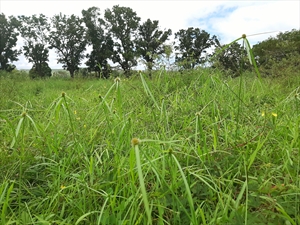Navua sedge
Pacific Pests, Pathogens, Weeds & Pesticides - Online edition
Pacific Pests, Pathogens, Weeds & Pesticides
Navua sedge (449)
Kyllinga polyphylla. It was known previously as Cyperus aromaticus. It is a member of the Cyperaceae.
South and Southeast Asia, Africa, South America, the Caribbean (restricted), Oceania. It is recorded from Australia, Federated States of Micronesia, Fiji, French Polynesia, New Caledonia, Samoa, Solomon Islands, and Vanuatu.
It is native to tropical Africa, Madagascar and Mauritius.
A vigorous grass-like aggressive weed that competes strongly with pasture and native plants, forming dense stands (Photos 1&2). It is important because of the amount of seed produced and aggressiveness of its clump-forming rhizomes. Apart from pastures, it occurs in coconut plantations, rice fields, gardens, ditches, and along roadsides. It is unpalatable to cattle and can rapidly invade overgrazed pastures.
The weed prefers areas with an annual rainfall over 2500 mm, without a distinct dry season. Where there is less rain and a distinct dry season, it is generally restricted to damp, low-lying pastures, drains or disturbed areas. In Fiji, it is a vigorous and noxious weed, occurring near sea level along roadsides, on hillsides and riverbanks, and in pastures, open swamps, and rice fields.
The sedge is a perennial plant, generally 30-70 cm tall, with an underground stem, called a rhizome, that produces shoots and roots along its length. Leaves, 5 cm long, 3 cm wide, arise from the rhizome at the bottom of a 3-sided stem. Flowers, at the top of the stem, form a tuft or knot of spikelets, surrounded by six, leaf-like structures, called bracts; three up to 12 cm long, three much shorter (Photos 3&4). Flowerheads are white, with many individual flowers (spikelets) (Photo 4). Seeds are brown to black, egg-shaped, with hook at one end. Each flowerhead produces about 250 seeds. In Solomon Islands, seed germination is said to be very low. The sedge has an aromatic smell when the underground stem is crushed, hence the old name 'aromaticus'.
Spread is by seed and rhizomes; seed can be spread in bird and other animal faeces, in mud on hooves, coats of animals, footwear and machinery. Stem pieces are spread during normal cultivation practices.
Navua sedge is a significant invasive weed. Its main impact is the damage it causes to the environment and to biodiversity. It grows rapidly, competing with native species for nutrients, light and moisture. Economic impact occurs when it invades and replaces tropical pasture species forming dense stands. In Fiji, carrying capacity of the pastures can be reduced by as much as 40%. In sugarcane, it is a problem where density of the crop is low with a poor canopy.
None reported
BIOSECURITY
There is a high risk of introduction of Navua sedge. Once established, it is extremely difficult to control. Countries not yet infested by Navua sedge should consider all likely pathways for entry, and apply quarantine measures accordingly.
Navua sedge has been ranked 12th in a list of non-indigenous weed species, not in cultivation, with potential to invade the USA. It is reported that Navua sedge is among the 10 worst weeds in Fiji, Samoa and Solomon Islands, and important in New Caledonia and Vanuatu.
BIOLOGICAL CONTROL
There have been no attempts at biological control. Waterhouse & Norris1 mention that before any attempts are made there is need to make sure that Navua sedge in Pacific island countries is the same as Kyllinga polyphylla of tropical Africa. There has been considerable confusion about the identification of Navua sedge. Recently, surveys by Queensland have been made in East and West Africa, and several pathogens are under test for host specificity.
CULTURAL CONTROL
- Physical & Mechanical:
- Dig out and turn over the plants, exposing the roots and making sure the aerial parts are covered.
- Disc large areas of the weed, bringing the roots to the surface, allowing them to dry out. Best to do this in dry times, otherwise there will be regrowth.
- Use heavy rollers on level ground to break stems. Repeat every 8-12 weeks.
- Hygiene:
- Treat vehicles and farm machinery. Wash down vehicles first before moving from areas where the weed occurs to those weed-free. Wash to remove soil and seed.
- Ensure seeds are not carried on clothes between infested and 'clean' areas.
- Maintenance of pastures:
- Keep pastures growing vigorously and in good condition to avoid navua sedge seedlings establishing. Especially avoid over-grazing by cattle. Recognising, and monitoring for the presence of Navua sedge, and then its treatment, are all very important.
CHEMICAL CONTROL
In Australia, glyphosate and halosulfuron-methyl are registered for Navua sedge. Follow-up treatments are required to treat the seedlings that germinate after the mature plants have been killed. In Fiji, MCPA.
--------------------
Note, EU approval to use glyphosate ends in December 2022; its use after that date is under discussion.
____________________
When using a pesticide, always wear protective clothing and follow the instructions on the product label, such as dosage, timing of application, and pre-harvest interval. Recommendations will vary with the crop and system of cultivation. Expert advice on the most appropriate herbicides to use should always be sought from local agricultural authorities.
AUTHORS Grahame Jackson, Aradhana Deesh & Mani Mua
Information from 1Waterhouse DF, Norris KR (1987) Kyllinga polyphylla. Biological Control Pacific Prospects. Inkata Press, Melbourne; and CABI (2019) Kyllinga polyphylla (Navua sedge). Invasive Species Compendium. (https://www.cabi.org/isc/datasheet/17492#toPictures); and from Navua sedge, Cyperus aromaticus (2020) Department of Agriculture and Fisheries, Biosecurity Queensland. (https://www.daf.qld.gov.au/__data/assets/pdf_file/0007/51010/navua-sedge.pdf). Photo 2 Jim Space, Pacific Island Ecosystems at Risk (PIER), Bugwood.org. Photo 3 James Cook University, Australia. Diagram Enler A (1910) Die Pflanzenwelt Afrikas, insbesondere seiner tropischen Gebiete: Grundzge der Pflanzenverbreitung im Afrika und die Charakterpflanzen Afrikas. Leipzig: W. Engelman.
Produced with support from the Australian Centre for International Agricultural Research under project HORT/2016/185: Responding to emerging pest and disease threats to horticulture in the Pacific islands, implemented by the University of Queensland, in association with the Pacific Community and Koronivia Research Station, Ministry of Agriculture, Fiji.








